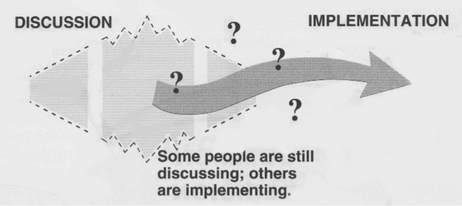Mission: Impact podcast & blog
Build a better world without becoming a martyr to your nonprofit cause
Listen on:
|
Teams, boards, task forces and other working groups often stumble over decision-making. It is often not actually about making decisions. Rather it is that the group has never had a conversation about how they make decisions – what is their process? Are they working on consensus? Majority rule? The boss decides? Often the group has a practice. Yet if that practice is not made explicit, then misunderstandings frequently occur. Have we decided or are we still discussing? A very useful model for understanding what often happens comes from Sam Kaner’s book, Facilitators Guide to Participatory Decision Making. When a group is considering an issue, ideally there is a discussion that considers a wide range of options. Then the discussion comes to a clear end point with a decision. Once a decision is made the group moves to action. This image illustrates this ideal.  What happens more frequently is that those who are more action oriented believe a decision has been made. At the same time those who want to consider more options believe the item is still under discussion. This image shows this too frequent reality of group process The value of separating the how from the what I was once on a large cross-functional team working together on an enterprise wide IT project. In doing some work with the team, I uncovered that one of the team members’ biggest fears was that each person, representing their department, would have wish list items. They feared the group would end up in conflict over priorities. And feared that a political process would override considering options on their merits. We took time before we had to make any specific decisions to talk through how we were going to make the decision. We framed overarching project goals and then agreed to prioritize the options/wish list items based on how they aligned with the goals. We then created a decision tree out of the criteria the group had jointly discussed. When it ultimately came time to prioritize our features list, the group was able to make the decision is just one meeting. The time we had spent up front saved the group time when it was decision making time and spared the group the conflict it feared. Discuss Decision Making Taking the time to have a discussion about how your group makes decisions helps take the guess work out of the equation. For each decision the team needs to be clear what issue is being decided. In the course of the discussion, multiple issues may have been raised making it a bit cloudy what is actually being discussed and decided. Then clarifying who is deciding this particular issue – is it a team decision? Would it be helpful to have a subset work on the issue and bring back a recommendation? Is the discussion serving as an input while the decision ultimately lies with the person in charge? Groups often want to jump to action and resist taking time on ‘process’ issues. Yet taking the time can actually save time in the long run.
I work with teams and organizations to improve their effectiveness, by identifying challenges that impede progress and helping the group create processes that will work for them. Have a team or group that needs help? Let's talk.  I allowed myself to take a break yesterday. I had been traveling for a chunk of the week and felt weary. My body and mind were telling me I needed a pause. Yet our go go culture abhors the break. When you are at your job and you are not being super productive instead of encouraging people to listen to your body and take a break, most work cultures want you to power through. Or at least pretend you are busy. Busy Bragging Rights Powering through was what I have done most of my life. I’ve played the “I’m more busy than you” game. I remember the one-up manship as early as when I was in college. ‘Oh geez got a paper due tomorrow and I haven’t started.” “Oh you think that is bad – I have a paper due and a test tomorrow.” And it continues – the endless cycle of bragging who is more overwhelmed by work. Multiple articles and studies have been done recently on the idea that busyness is a new status symbol. “I am a very busy and important person – you have two minutes to make your pitch.” I spent much of my teens and twenties sleep deprived. I’m not interested in winning this game any more. Recharging And today I just proved it doesn’t work anyway. After just 24 hours of a little rest and relaxation, I came back to my to do list fired up and moved through it with ease. I got more done today than I have in a while. And certainly more than if I had plodded through yesterday which would have spilled over into plodding through today. We are not machines A work ethic is critical. Yet lots of science is demonstrating that through our economy is made for machines – we have to remember we are actually NOT machines. In addition, much work today is now knowledge work that requires creativity and innovation. These require white space. They require all the things you were either told not to do growing up – day dreaming, for example. Or the things that weren’t necessarily valued - time away from work – play – time in nature. I don’t need to go to Arianna Huffington’s extreme of collapsing from exhaustion to agree with her assertion that our constantly busy ethic is killing us. Is rest just to make you more productive? At the same time, my argument is a little perverse – or at least still representative of our culture. My reason for a pause is to recharge to be able to get back to work and be more productive. I would call myself a recovering ‘productivity-a-holic.’ I can aspire to relaxing into taking a pause for the sake of taking a pause, rather than to just make me more productive later.
Most organizations believe they keep their end user, audience, members or customers front of mind when they are creating new programs or service offerings. Yet often this is based on preconceived notions about members, beliefs developed from a staff member’s time in the field, or based on interactions with a few of their volunteer leaders. It is rarely based on an in depth exploration of the day-to-day work life of their members. Qualitative research digs into their experience and has the opportunity to uncover unmet needs. |
Archives
April 2024

Grace Social Sector Consulting, LLC, owns the copyright in and to all content in and transcripts of the Mission: Impact podcast, as well as the Mission: Impact blog with all rights reserved, including right of publicity.
|
Telephone301-857-9335
|
info[at]gracesocialsector.com
|
Grace Social Sector Consulting, LLC, owns the copyright in and to all content in, including transcripts and audio of the Mission: Impact podcast and all content on this website, with all rights reserved, including right of publicity.
|